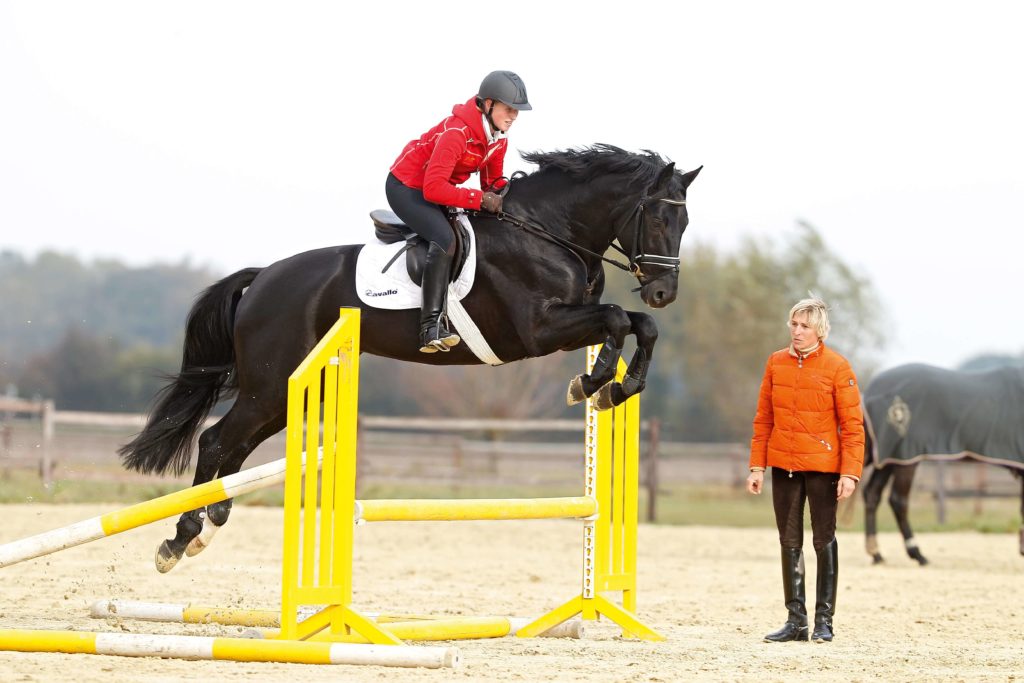This excerpt from “Ride Better with Christopher Hess” by Christopher Hess is reprinted with permission of Trafalgar Square Books.
In this excerpt from his book Ride Better with Christoph Hess, FEI judge and renowned educator Christoph Hess explains how schooling over a single fence can still offer great benefit to horse and rider.
Work over a single fence has good value that relates to later being able to ride an entire course with control. It’s a challenge for the rider, especially when she jumps back and forth over the fence on a straight line through the center of the arena (without depending on the rail). Therefore, working over a single fence can be extremely instructive and interesting for every rider and every horse.
 Photo by Jacques Toffi.
Photo by Jacques Toffi.
The Basics Must Be Right
Before riding over a jump, you need to already be solid in your dressage-oriented work to a certain point. You must be able to ride with short stirrups, remaining balanced and supple in both a dressage and light seat. As for your horse, both “gas” and “brakes” need to be working well, as Hermann Schridde, former coach for the German National Show Jumping Team, would say.
To put it another way, “Jumping is dressage riding perfected.” This means you must be able to ride your horse with long and short canter strides, so that he lightly turns from your aids in both directions and also easily executes both upward and downward transitions. The more responsively your horse accepts your driving, slowing, and turning aids, the better he will be able to jump each fence.
It poses a high level of challenge to horse and rider when, after a single fence, the rider transitions the horse down to a walk, changes direction through a half-circle, and then picks up the canter again.
From Single Fence to Jump Course
In fact, in the warm-up arena at many competitions, there is only a single vertical and a single oxer for the riders to school over. Here, the rider must school her horse so that afterward he completes an entire course as well as possible. What situations must be schooled over the jump? Jumping from a normal distance, as well as long and close. Approaching the jump from both a slower and a more accelerated tempo. In addition, practice approaching from a “long” line as well as out of a turn (from right and left). You can practice jumping over the fence on an angle, as well as turning immediately after landing, as long as the horse has already mastered departing from the fence and traveling farther on a straight line.
When you need to have meaningful schooling sessions using only a single fence, you should consider these different factors involved with approaching, crossing, and departing from a fence. Experience shows that oftentimes problems riders are having on a jump course can best be most practically and effectively resolved by systematic schooling over a single fence. In this scenario, the rider has the most influence over the horse’s direction, tempo, rhythm, impulsion, straightness, and balance.
From Easy to Difficult
It’s good practice to set up a ground pole about 2.5 meters (8 feet) in front of the jump—a cross-rail—and approach from the trot. (I prefer using a raised cavalletto, rather than a pole on the ground, because it won’t roll away.)
In the beginning, you should ride about three times over this “line of jumps,” approaching from a long line in the posting trot—in a calm, controlled tempo—with your horse securely in front of your driving aids. You should approach the jump from both the left and right. After the jump, you should maintain a straight line, and using your driving aids, transition from the canter to the trot, and then ride forward into the walk.
After you’ve jumped the cross-rail successfully, you can try a small vertical (80 centimeters—30 inches—in height) with a ground pole. The ground pole/cavalletti should be about 10 to 20 centimeters—4 to 8 inches—farther away from the jump.
Once you’ve jumped this successfully from a controlled trot, approaching from both directions, you can also try from the canter. Before you try jumping from the canter, you need to be able to ride a forward canter in a light seat, both lengthening and shortening the canter strides from the lightest aids at any moment. When you can do so, your horse will be able to master departures from both longer and shorter distances without a problem.
The ground pole/cavalletto should be placed about 3 meters (10 feet) ahead of the jump. It’s important to ride to the jump on a straight line with a fluid, even tempo. You should have an even, soft contact with the horse’s mouth and fix your eyes on the top rail of the jump—don’t look down at the ground pole that’s in front of the jump.
Once you’ve jumped the fence in this manner about three times, I’d suggest you could change the jump from vertical to oxer. The ground pole can be moved slightly closer to the fence. You should not change anything about how you ride the approach. As before, it’s important to ensure an energetic, but controlled, canter.
Your ability to follow the movement of your horse should not change as you ride over the vertical or the oxer.
Pick up your copy of Ride Better with Christopher Hess by Christopher Hess here.

